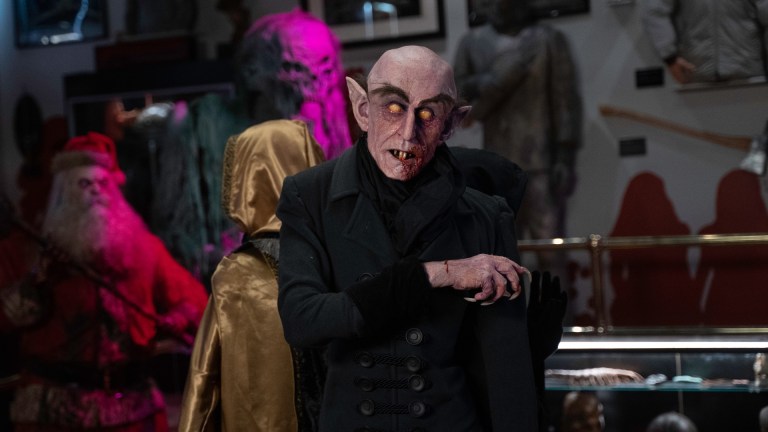Creepshow: Greg Nicotero Unpacks the Skeletons in His Closet
Gore maestro Greg Nicotero talks about all the horror Easter eggs in some of his most personal Creepshow episodes.

For more than 35 years, Greg Nicotero has not only played in a lot of sandboxes within the horror genre, he built the toys that go inside. When he talks about the work of John Carpenter, Don Coscarelli, Sam Raimi, and George Romero, he’s not doing so only as a fan, but as a colleague. As a special makeup effects artist who evolved into a director and executive producer he doesn’t only get to tell the stories he wants to, he can pay homage to the films and filmmakers he admires.
Though that admiration has been on display for years through his work as a director and EP on The Walking Dead — for which he’s still in the process of shooting the eleventh, and final, season — Nicotero seems to be having a grand time crafting love letters to horror as showrunner on Creepshow, the anthology series on the Shudder platform in its third season.
In our recent video interview with him, Nicotero describes Creepshow season 2 stories “Public Television of the Dead,” “Model Kid,” and “Night of the Living Late Show” as very personal because each spoke to a different aspect of his life.
“Whether it was my collaboration with Sam Raimi, my love for monster models, or the game I used to play with the guys in the shop: If you could go back in time and be in any movie, what would it be?”
But the story “Skeletons in the Closet,” in the latest episode of Creepshow has it “all in there,” and might be the peak of Nicotero’s nerd-out. Directed by Nicotero, with a story by him and John Esposito, it is a tale about an obsessive movie prop collector who takes things a bit far by stealing a screen-used skeleton.
Between the endless stream of movie quotes, the collector’s memorabilia (most of which is the real deal) to a re-creation of the Psycho shower scene and a Ray Harryhausen skeleton fight from The 7th Voyage of Sinbad, this installment of Creepshow is an Easter egg feast for horror fans.
In the following excerpt from our interview, Nicotero breaks down the Creepshow story, and in the accompanying video, we likewise discuss the John Carpenter homage (and practical monster effects) in the “Queen Bee” story, as well as his working relationship with Joe Hill, and the relevance of social commentary within horror.
On the origins of “Skeletons in the Closet”
“‘Skeletons’” came about because it’s based pretty much on a true story,” Nicotero says. “After Dawn of the Dead was filmed, there was a skeleton used in the movie found in a costume shop in Pittsburgh. They called the coroner, and he was like, ‘This is a real skeleton,’ and they gave it a burial. That all really happened. I was always fascinated with the idea you could get, at one point, real skeletons. Where did they come from? Whose skeleton was it? Did some guy go out and kill somebody, and use their skeleton for a movie? No. My first job on Day of the Dead when I got hired by Tom Savini was to call a medical supply place and order skeletons. They came from India or somewhere.”
The real movie props on display
“Most of the stuff in that museum is stuff from my actual collection, up to and including my favorite joke, which I am probably the only who will laugh at it: The decapitated head of David Warner from The Omen,” Nicotero says. “While we were writing that, that head went up for auction, and I won. I actually bought it. We have it and restored it. That was the first movie decapitation I remember seeing that blew me away.”
The Omen isn’t the only prop on display, with a photo of the mysterious sphere from Phantasm also making an appearance.
“I called Don Coscarelli [and] said I was doing a Phantasm homage and wanted permission,” he says. “I wanted him to know we were giving this nod to him. He was super down for it.”
On that skeleton fight
“[I had] a Super 8 The 7th Voyage of Sinbad skeleton fight that I probably played forwards, backwards, sideways, upside down a hundred thousand times,” Nicotero says. “I really wanted to do the ultimate homage to Ray Harryhausen. We ended up not doing those stop motion, which I would have preferred. There’s just so many shots that I don’t think we would have been able to do it in the time frame. But the VFX company did an amazing job. I used the same framing and same shots from Jason and the Argonauts and 7th Voyage because I wanted it to feel like a Ray Harryhausen sequence.”
The significance of filming the Psycho shower scene
Nicotero describes recreating the Psycho shower scene as “one of the most unique experiences” of his entire career.
“You get to a point where you have to deconstruct every shot, and wonder why [Hitchcock] did this, and what piece of equipment he needed to do it,” he says. “The most interesting thing was being in there while we were shooting it, and seeing the red blood against the white tile, and realizing how shocking…to see how gory it was,” he says.
“If that movie had been shot in color, that scene would have been much more shocking – which is hard to imagine. I really loved deconstructing that, and looking at every single frame. There was only one shot we didn’t end up doing out of the entire sequence. There was an overhead shot looking down where we saw Marion in the shower, and Norman from the top. We weren’t able to do it just because we didn’t have time. I shot that whole scene in three hours.”
